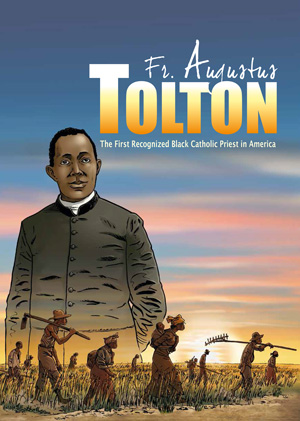Father Tolton: Reflecting Christ at a Time of Racial Strife
Learn the inspiring story of the first African-American priest in America.

SERIOUS CARTOONS. This comic book will educate young readers about a heroic priest. Courtesy of Maria and Corinna Laughlin
One hundred and 30 years ago, after his ordination in Rome on Easter Sunday, Father Augustus Tolton returned home to the United States and celebrated Mass for a community of Franciscan sisters. Not only was the occasion the fulfillment of a promise made six years earlier to his friend Sister Perpetua, it also marked a milestone in U.S. history: Sister Perpetua memorialized the event in the community records and wrote, “The first Mass in the United States by the first African-American priest and ex-slave was celebrated on Wednesday, July 7, 1886, in the chapel of St. Mary’s Hospital in Hoboken, N.J.”
The story of Father Tolton has now been recounted in a new comic book, Father Augustus Tolton: The First Recognized Black Catholic Priest in America. The book was the inspiration of Auxiliary Bishop Joseph Perry of the Archdiocese of Chicago, who is also a member of the U.S. bishops’ Subcommittee on African-American Affairs and the postulator for Father Tolton’s cause for sainthood.
Bishop Perry explained the book’s purpose. “I was introduced to Edition du Signe (French publishing company) by Jac Treanor, the archivist for the Archdiocese of Chicago. He showed me a comic book done for an anniversary of the Archdiocese of Seattle, and I was captivated by the layout and the striking color and scenes. I immediately thought, ‘How nice a similar book could work for getting the story out about Father Augustus Tolton, whose cause for sainthood is pending in Rome.’”
From the opening illustration, Father Tolton’s road to sanctification is apparent, as riveting scenes unfold in swift succession. Images dramatize his cruel life of slavery, his harrowing escape with his widowed mother to freedom, his life of poverty and unsuccessful attempts to gain acceptance into an American seminary. He eventually attended seminary at Collegium Urbanum de Propaganda Fide, which is located in Rome. Undaunted, after ordination, he suffered increasing resistance within the Church, publicly advocating for interracial parishes and worship.
“Comic strips are funny, but in France they don’t use the term ‘comic book’ at all,” said Corinna Laughlin, who, with her identical twin sister Maria, wrote the book. Both are members of the staff at Seattle’s St. James Cathedral. “They call it bande dessinée, which means drawn panels, and these are considered graphic novels that are quite serious.”
Edition du Signe selected the Laughlins to co-author the Father Tolton book because the sisters had also co-authored the same publisher’s comic book for the Archdiocese of Seattle, which Bishop Perry saw and liked.
“We were like the directors in a movie,” said Maria, explaining the unique writing process. “We created a script to describe the scenes for each page. And then Bishop Perry and other people from Chicago proofed the script.”
Once the script was approved, it was sent to the illustrator to create the black-and-white images, which were finally completed by the colorist. “The images are really what tell the story,” Maria said, “so we inserted a minimum of text in order to keep the words secondary to the images.”
“The goal of the book,” said Bishop Perry, “is to attract interest in wanting to learn more about this pioneer priest of race relations in this country, by appealing to all audiences, young and old, with a story that is backed up by scenes from Tolton’s life as they would possibly look in the 19th century.”
Following his concept, illustrations are based upon research collected by the Laughlins in Chicago and in Quincy, Ill., where Father Tolton lived after his escape from slavery and for a short while after ordination. “The thing we were trying to accomplish by visiting the places,” said Corinna, “was to collect images for the artist, who lives in France. This gave him a feel for the place, including buildings, landscapes and costumes.”
Their findings also helped the Laughlins to present a compelling characterization of Father Tolton, showing his humorous and musical sides.
Also pivotal to the tale was the priest’s mother. “Tolton’s mother was an amazing woman of faith,” Maria said. “His whole life, she was proud of him and supported him until the bitter end.”
Until his death in 1897, Father Tolton was a “sign of contradiction.” As Bishop Perry explained, “Given the separation of the races in the U.S. ordered by law and lawless custom during 19th-century Reconstruction, a Roman collar around the neck of a black man was a sensation for the black community and something of a conundrum for the majority of society. While the world hardly noticed, Father Tolton walked among us as a Christ figure. His life says something remarkable to everyone about navigating disappointment, frustration, loneliness and letdown, but with faith, hope and love intact.”
Inspired by his witness, Maria shared personal insights. “Tolton’s story is about racism, for sure. But it’s also a story about vocation. To think of all that he suffered to become a priest, and yet continued to believe in his vocation, should inspire everyone who aspires to any kind of a vocation in the Church to read this book. I wish that every young man considering a vocation to the priesthood could read this and see how Tolton continued to pursue his call, in spite of everything.”
Jennifer Sokol writes from
Shoreline, Washington.
INFORMATION
ToltonCanonization.org
- Keywords:
- african-american catholics
- church history
- church in america
- father augustus tolton
- jennifer sokol
















